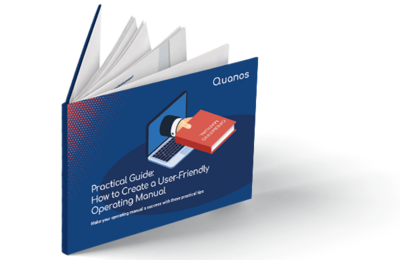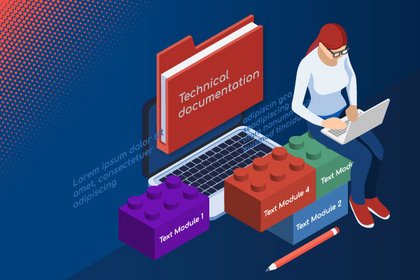Proofreading in Technical Documentation: How Writers and Editors Can Make an Effective Team
Proofreading is one of the sticking points in any publication process. It comes at the end of the process chain, at a point when everyone just wants to wrap things up. But it doesn’t have to be stressful. Read on to find out how you as a technical writer can reduce errors, streamline proofreading, and work constructively with your colleagues.

There is a part of the technical writing process that almost every company has a different name for: in addition to review, editing, and proofreading, it may also be called QA, approval, or error correction. However, no matter what it’s called, this phase isn’t particularly popular in most companies. At the end of the day, the goal is to discover and eliminate errors that have occurred up to this point. And who likes to make mistakes or then clean them up? In this blog post you’ll learn how to eliminate potential errors during the writing process and how to make collaboration between writers and reviewers as enjoyable and efficient as possible.
How to take the pressure off reviewers ahead of time
You’ve got a product launch coming up, but the technical documentation team can’t seem to get past the approval process. One way of speeding up this critical phase in technical writing is by reducing the potential for errors during writing and layouting. Here’s how to do it:
Reduce errors by reusing content and layout templates
Proofreading is of course required even if no errors have been made. After all, it is difficult to ascertain if there are any errors or not unless a text is checked. However, proofreading is not required if you know that absolutely no errors can be made. If you work with a content management system, then you will reuse many modules. Proofreading therefore becomes much more streamlined, as error checking only takes place on the original module and not on the many manuals that reuse this module.
The same also applies to the layout. If manuals are layouted manually, a lot of work goes into smoothing out lots of little things. An automated layout eliminates the majority of this “fiddly” work. Once you have an automated layout set up, you can cut out the majority of the proofreading work. If the layout is incorrect, this almost always means that the content is classified and marked incorrectly. And this is usually noticeable when the content module is being proofread (see above).
Use automatic error detection
If you want to streamline the proofreading process it’s important that the causes of the errors are fixed, not just the errors themselves. Of course this may not always be possible, but in these cases it should at least be ensured that the error can be detected automatically as far as possible if the root cause cannot be rectified.
There are a number of starting points for this in the digitalized authoring processes. First up are tools that are now taken for granted, such as spellcheck in Word. Controlled language systems, which also identify stylistic errors using linguistic algorithms, are considerably more powerful.
But in many cases, linguistic aspects aren’t the only errors that stand out when proofreading technical documentation. A content management system also enables the structure of the texts to be checked (in addition to many linguistic points). This means you can determine whether text items are missing, are in the wrong place, are too long, and much more. The fact that these searches and checks can be saved and called up automatically is particularly helpful. This way, you’re always using the same approach for your quality checks.
1. Be open to criticism as a technical writer
Proofreading starts with ourselves. Many proofreaders find it difficult to criticize others. It is even more difficult when criticism is only reluctantly accepted. There are different ways to reject criticism:
- “We’ve always done it this way.”
- “We can’t change that now.”
- “We don’t need this info.”
Sure, criticism can be annoying. But every criticism helps, even if it seems irrelevant – because it then shows us where a text is met with resistance or where there is ambiguity.
Being open to criticism does not mean implementing every criticism. Instead, it means being grateful for corrections and explaining which criticism helps, which helps in principle (but cannot be implemented due to cost or time constraints), and which criticism does not help for certain reasons. This means everyone learns from each other and the next stage of the proofreading process will run even more smoothly and successfully.
2. Give clear instructions to the reviewers and be transparent about where things are at
Speaking of learning from one another: often there are problems in proofreading because the reviewer doesn’t know what’s expected of them. This begins with things as simple as the time horizon: when does the text need to be edited? And no, it’s not enough for the proofreaders to know when the text is going to be published. In addition, reviewers need to know what type of review is expected of them.
- Is it only about content?
- Should the spelling be checked?
- Does the layout need to be corrected?
Editing is split into different stages: first the content, then the language, then the spelling, and finally the layout. It’s important for the proofreaders to know at what stage their revision is and why it’s not worth doing later tasks in advance.
3. Set realistic quality targets for proofreading
It is particularly important to intentionally set a quality goal. This must be appropriate for the resources available in the technical writing department and the speed requirements for publication.
The higher the quality requirements, the more resources and the more time needed. For example, if you have to ensure that there are no spelling errors in a manual, then it is not enough to simply have the intern read through the document again at the end. Publishers that often have such requirements organize their proofreading process in these cases according to an iterative four-eyes principle. This means that two proofreaders correct a manuscript until nobody can find any errors in the corrected versions.
As you can already appreciate, for a technical writing department with tight deadlines, this is realistic for a few individual pages at most. However, conversely, this also means that spelling errors should be checked and corrected. Realistically, it cannot be expected that manuals will be completely free of errors though.
4. Standardize the revision process
In addition to the “what” of the review, the “why” is also important. The results of proofreading are significantly better if a documented revision process exists:
- Should standard proofreader’s marks be used (and does the proofreader know these)?
- Or should the Word review function be used instead?
- Should errors be pointed out even if they are obvious and can be rectified immediately?
- Should only the facts be presented during the technical review or should suggestions on wording be made straight away?
Proofreading has many aspects and it’s best to clarify these before starting the revision process. They can also be written down in a review style guide or a checklist so that they are always on hand for new proofreaders.
In addition, reviewers should know which formulation standards were used for the respective text. In the case of technical documentation, these are usually the terminology and the style guide. Otherwise, the proofreading results will contain many comments that have already been decided.
5. Show your reviewers some appreciation
Proofreading is never an easy task. It requires accuracy, even though there is usually time pressure. It requires precise analysis of the content and tact when formulating criticism. Not many proofreaders are truly excellent in the revision process.
So it’s worth expressing your appreciation for them. A word of gratitude or small act of kindness is usually enough. For example, a small bar of chocolate or a homemade jam shows proofreaders how much you appreciate their cooperation.
6. Measure success
The goal of editing is avoiding errors. So, there is nothing more frustrating than a never-ending task where reviewers get the sense that the same mistakes are occurring again and again. It is therefore a good idea to set goals for which errors you want to permanently reduce in editing. For example, this might be the number of comments in the technical revision.
A concrete measurement of success creates an incentive to eliminate this type of error in advance, e.g., through more detailed research or better documentation of the results. This means that these errors will gradually become less common. The review workload is reduced and those involved are more satisfied.
Conclusion: Tap your potential and make proofreading more efficient
Proofreading is a critical step in the publication process with the aim of identifying errors and weaknesses and getting the best out of a text. To make proofreading more effective, technical writers should be open to criticism and gratefully accept corrections, even if they aren’t always what they want to hear.
Clearly defined work instructions are crucial for avoiding misunderstandings and giving proofreaders clear guidelines. The standardization of the revision process and use of style guides or checklists improve the quality of the results. Showing your appreciation to proofreaders through small gestures of gratitude helps them to feel valued and motivated. Finally, it’s important to measure the success of the revision process and set concrete goals in order to reduce recurring errors. Through continuous improvements and efficient error prevention, the revision process will run more smoothly, increasing the satisfaction of everyone involved.
Practical Guide: How to Create a User-Friendly Operating Manual

How can you create a user-friendly operating manual that meets more than just legal requirements? A document that provides customers and technicians with valuable information about your product in every situation, presented in an understandable and visually appealing way? We answer these questions in this practical guide.


